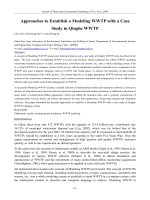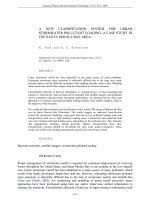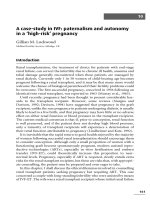- Trang chủ >>
- Y - Dược >>
- Ngoại khoa
oxford case histories in rheumatology
Bạn đang xem bản rút gọn của tài liệu. Xem và tải ngay bản đầy đủ của tài liệu tại đây (2.74 MB, 300 trang )
Oxford Case
Histories in
Rheumatology
Oxford Case Histories
Series Editors
Sarah Pendlebury and Peter Rothwell
Published:
Neurological Case Histories (Sarah Pendlebury, Philip Anslow, and
Peter Rothwell)
Oxford Case Histories in Cardiology (Rajkumar Rajendram,
Javed Ehtisham, and Colin Forfar)
Oxford Case Histories in Gastroenterology and Hepatology (Alissa Walsh,
Otto Buchel, Jane Collier, and Simon Travis)
Oxford Case Histories in Respiratory Medicine (John Stradling, Andrew
Stanton, Anabell Nickol, Helen Davies, and Najib Rahman)
Oxford Case Histories in Rheumatology (Joel David, Anne Miller, Anushka
Soni, and Lyn Williamson)
Forthcoming:
Oxford Case Histories in Neurosurgery (Harutomo Hasegawa, Matthew
Crocker, and Pawanjit Singh Minhas)
Oxford Case Histories in TIA and Stroke (Sarah Pendlebury, Ursula Schulz,
Aneil Malhotra, and Peter Rothwell)
1
Oxford Case
Histories in
Rheumatology
Joel David
Consultant Rheumatologist and Lead Physician,
Nuffield Orthopaedic Centre,
Oxford, UK
Anne Miller
Associate Specialist in Rheumatology,
Nuffield Orthopaedic Centre,
Oxford, UK
Anushka Soni
Clinical Lecturer in Rheumatology,
University of Oxford,
Oxford, UK
Lyn Williamson
Consultant Rheumatologist,
Great Western Hospital,
Swindon, UK
1
Great Clarendon Street, Oxford ox2 6dp
Oxford University Press is a department of the University of Oxford.
It furthers the University’s objective of excellence in research, scholarship,
and education by publishing worldwide in
Oxford New York
Auckland Cape Town Dar es Salaam Hong Kong Karachi
Kuala Lumpur Madrid Melbourne Mexico City Nairobi
New Delhi Shanghai Taipei Toronto
With offices in
Argentina Austria Brazil Chile Czech Republic France Greece
Guatemala Hungary Italy Japan Poland Portugal Singapore
South Korea Switzerland Thailand Turkey Ukraine Vietnam
Oxford is a registered trade mark of Oxford University Press
in the UK and in certain other countries
Published in the United States
by Oxford University Press Inc., New York
© Oxford University Press, 2012
The moral rights of the author have been asserted
Database right Oxford University Press (maker)
First published 2012
All rights reserved. No part of this publication may be reproduced,
stored in a retrieval system, or transmitted, in any form or by any means,
without the prior permission in writing of Oxford University Press,
or as expressly permitted by law, or under terms agreed with the appropriate
reprographics rights organization. Enquiries concerning reproduction
outside the scope of the above should be sent to the Rights Department,
Oxford University Press, at the address above
You must not circulate this book in any other binding or cover
and you must impose the same condition on any acquirer
British Library Cataloguing in Publication Data
Data available
Library of Congress Cataloguing in Publication Data
Library of Congress Control Number: 2011939859
Typeset in Minion by Cenveo, Bangalore, India
Printed in Great Britain
on acid-free paper by
CPI Group (UK) Ltd, Croydon, CR0 4YY
ISBN 978–0–19–958750–6
10 9 8 7 6 5 4 3 2 1
Oxford University Press makes no representation, express or implied, that the drug
dosages in this book are correct. Readers must therefore always check the product
information and clinical procedures with the most up-to-date published product
information and data sheets provided by the manufacturers and the most recent codes of
conduct and safety regulations. The authors and the publishers do not accept responsibility
or legal liability for any errors in the text or for the misuse or misapplication of material in
this work. Except where otherwise stated, drug dosages and recommendations are for the
non-pregnant adult who is not breastfeeding.
A note from the series editors
Case histories have always had an important role in medical education, but most
published material has been directed at undergraduates or residents. The Oxford Case
Histories series aims to provide more complex case-based learning for clinicians in
specialist training and consultants, with a view to aiding preparation for entry- and
exit-level specialty examinations or revalidation.
Each case book follows the same format with approximately 50 cases, each compris-
ing a brief clinical history and investigations, followed by questions on differential
diagnosis and management, and detailed answers with discussion.
All cases are peer-reviewed by Oxford consultants in the relevant specialty. At the
end of each book, cases are listed by mode of presentation, aetiology, and diagnosis.
We are grateful to our colleagues in the various medical specialties for their enthusiasm
and hard work in making the series possible.
Sarah Pendlebury and Peter Rothwell
From reviews of other books in the series:
Neurological Case Histories
‘…contains 51 cases that cover the spectrum of acute neurology and the neurology of
general medicine—this breadth makes the volume unique and provides a formidable
challenge… it is a heavy-duty diagnostic series of cases, and readers have to work hard,
to recognise the diagnosis and answer the questions that are posed for each case… I
recommend this excellent volume highly…’
Lancet Neurology
‘This short and well-written text is…designed to enhance the reader’s diagnostic abil-
ity and clinical understanding…A well-documented and practical book.’
European Journal of Neurology
Oxford Case Histories in Gastroenterology and Hepatology
‘…a fascinating insight in to clinical gastroenterology, an excellent and enjoyable read
and an education for all levels of gastroenterologist from ST1 to consultant.’
Gut
This page intentionally left blank
Preface
This book contains a series of case histories that the authors have encountered in the
Oxford region. The purpose of the cases is to provide trainees, and indeed all practi-
tioners in rheumatology, with clinical scenarios and an evidenced approach to answering
questions raised by the cases. It is hoped that the book will be useful for training as well
as in preparation for exit examinations. The book may also be helpful for rheumatologists
in their re-validation. General medical trainees might find it useful in preparation for
MRCP and PACES.
Many of the cases require clinical judgement in the approach to the management
decisions and questions. The authors have expressed their views and hope that you
generally agree! The cases cover inflammatory joint and connective tissue disease,
paediatric rheumatology, sports and exercise medicine, and metabolic bone disease.
Some of the cases include acute presentations and others are more chronic muscu-
loskeletal and mechanical problems where there are dilemmas in clinical practice.
The authors have used the format of case reports, with detailed discussions of dif-
ferential diagnosis and management, for three reasons. First, one of the best ways to
learn advanced clinical medicine is through the analysis of individual cases. In almost
all areas of medicine it is extremely difficult to illustrate the practical process of diag-
nosis within the format of a traditional textbook. Secondly, it is simply more interesting
to consider real cases than to read a text. This allows a clinician to reflect on their own
differential diagnosis and treatment. Finally, there is a lack of case series that stretch
the abilities of experienced clinicians and specialists: most are aimed at medical students
or young doctors doing early postgraduate exams. It is for this reason that the cases
and questions are sometimes challenging, although many are simple since the aim is
to educate. Wherever possible radiology and clinical pictures have been included.
The authors would like to thank their colleagues, including those allied to medicine, for
contributing cases and providing illustrations or administrative support. The clinicians
who contributed cases are listed in the Acknowledgements.
We hope you enjoy the book!
Joel David
Anne Miller
Anushka Soni
Lyn Williamson
This page intentionally left blank
Acknowledgements
Dr Kuljeet Bhamra
Miss Jane Flynn
Dr Lawrence John
Dr Maria Juarez
Dr Sarah Keidel
Ms Fiona Kinnear
Dr Lucy Mackillop
Dr Kulveer Mankia
Dr Brendan McDonald
Dr Ishita Patel
Dr Elizabeth Price
Dr Nick Ridley
Dr Joanna Robson
Dr Shilpa Selvan
Dr Bill Smith
Dr Anisha Sodha
Dr Ravi Suppiah
Dr Rosemary Waller
Dr Thamindu Wedatilake
Dr Luke Williamson
This page intentionally left blank
Contents
Abbreviations xiii
Table of normal ranges xv
Cases 1–46
1
List of cases by diagnosis
270
List of cases by aetiological mechanisms
271
Index
273
This page intentionally left blank
AAS atlanto-axial subluxation
ABPI ankle–brachial pressure index
ACCP anticitrullinated C-peptide
(also referred to as ACPA)
ACE angiotensin-converting enzyme
aCL anticardiolipin antibody
ALP alkaline phosphatase
ANA antinuclear antibody
ANCA antineutrophil cytoplasmic
antibody
AND adverse neural dynamics
APS antiphospholipid syndrome
APTT activated partial thromboplastin
time
AS ankylosing spondylitis
ASOT antistreptolysin-O titre
AST aspartate transaminase
BASDAI Bath Ankylosing Spondylitis
Disease Activity Index
BD Behçet’s disease
BMD bone mineral density
BMI body mass index
BSR British Society for Rheumatology
CK creatine kinase
CMV cytomegalovirus
CNSV central nervous system
vasculitic
COX-2 cyclo-oxgenase-2
CPK creatine phosphokinase
CREST calcinosis, Raynaud’s,
(o)esphageal involvement,
sclerodactyly, telangiectasia
CRMO chronic relapsing multifocal
osteomyelitis
CRP C-reactive protein
CRPS complex regional pain syndrome
CSF cerebrospinal fluid
CSS Churg–Strauss syndrome
CT computed tomography
CTX carboxy-terminal collagen
crosslinks
CXR chest X-ray
DAS Disease Activity Score
DEXA dual-energy X-ray
absorptiometry
DILS diffuse infiltrative lymphocytosis
syndrome
DISH diffuse idiopathic skeletal
hyperostosis
DMARD disease-modifying
anti-rheumatic drug
EBV Epstein–Barr virus
ECG electrocardiogram
EF eosinophilic fasciitis
EIA enzyme immunoassay
ELISA enzyme-linked immunosorbent
assay
EMG electromyography
ENA extractable nuclear antigen
ESR erythrocyte sedimentation rate
EULAR European League Against
Rheumatism
FBC full blood count
FMF familial Mediterranean fever
FSH follicle-stimulating hormone
GACNS granulomatous angiitis of the
central nervous system
GCA giant cell arteritis
GFR glomerular filtration rate
GGT gamma glutamyl transferase
GH growth hormone
GPA granulomatosis with polyangiitis
(also known as Wegener’s
granulomatosis (WG))
HA haemophiliac arthropathy
Hb haemoglobin
HLA human leucocyte antigen
hpf high-power field
Abbreviations
ABBREVIATIONS
xiv
IBD inflammatory bowel disease
IGF-1 insulin-like growth factor 1
INR international normalized ratio
IP interphalangeal
IRIS immune reconstitution
inflammatory syndrome
JIA juvenile idiopathic arthritis
LA lupus anticoagulant
LDH lactate dehydrogenase
LFT liver function test
LH luteinizing hormone
MAGIC mouth and genital ulcers with
inflamed cartilage
MAS macrophage activation
syndrome
MCP metacarpophalangeal
MCV mean cell volume
MEN-I multiple endocrine neoplasia I
MHC major histocompatibility
complex
MPA microscopic polyangiitis
MRA magnetic resonance
angiography
MRI magnetic resonance imaging
MSCRAMM microbial surface components
recognizing adhesive matrix
molecules
MTSS medial tibial stress syndrome
NICE National Institute of Clinical
Excellence
NOF neck of the femur
NSAID non-steroidal anti-
inflammatory drug
NSIP non-specific interstitial
pneumonia
NTX cross-linked N-telopeptides of
type 1 collagen
NYHA New York Heart Association
OA osteoarthritis
OI osteogenesis imperfecta
PACNS primary angiitis of the central
nervous system
PAN polyarteritis nodosa
PAS periodic acid–Schiff
PCR polymerase chain reaction
PET positron emission tomography
PFJ patello-femoral joint
PFPS patello-femoral pain syndrome
PMR polymyalgia rheumatica
PT prothrombin time
PTH parathyroid hormone
PTT partial thromboplastin time
PUK peripheral ulcerative keratitis
PUO pyrexia of unknown origin
RA rheumatoid arthritis
RBC red blood cell
RCVS reversible cerebral
vasoconstrictive syndrome
RF rheumatoid factor
RP relapsing polychondritis
SAP serum amyloid protein
SAPHO synovitis, acne, pustulosis,
hyperostosis, and osteitis
SD standard deviation
SHBG sex-hormone-binding globulin
SLE systemic lupus erythematosus
SOJIA systemic-onset juvenile
idiopathic arthritis
STIR short T
1
inversion recovery
TakA Takayasu’s arteritis
TENS transcutaneous electrical nerve
stimulation
TFT thyroid function test
TGF- β transforming growth factor- β
TNF tumour necrosis factor
TPHA Treponema pallidum
haemagglutination test
TSH thyroid-stimulating hormone
U&E urea and electrolytes
VAS Visual Analogue Score
VDRL Venereal Disease Research
Laboratory
VMO vastus medialis obliterans
VS ventral subluxation
VTE venous thromboembolism
VZV varicella zoster virus
WBC white blood cell
WCC white cell count
WG Wegener’s granulomatosis
(also known as granulomatosis
with polyangiitis (GPA))
Normal ranges
Haematology
haemoglobin
males g/L (130–180)
females g/L (115–165)
MCV fL (80–96)
white cell count ×10
9
/L (4.0–11.0)
neutrophil count ×10
9
/L (1.5–7.0)
lymphocyte count ×10
9
/L (1.5–4.0)
monocyte count ×10
9
/L (<0.8)
eosinophil count ×10
9
/L (0.04–0.40)
platelet count ×10
9
/L (150–400)
CD4 count ×10
6
/L (430–1690)
erythrocyte sedimentation rate
under 50 years:
males mm/ h (<15)
females mm/ h (<20)
over 50 years:
males mm/ h (<20)
females mm/ h (<30)
Haematinics
serum iron μmol/L (12–30)
serum iron-binding capacity μmol/L (45–75)
serum ferritin μg/L (15–300)
serum transferrin g/L (2.0–4.0)
Chemistry
Blood
serum sodium mmol/L (137–144)
serum potassium mmol/L (3.5–4.9)
serum creatinine μmol/L (60–110)
estimated glomerular filtration rate mL/min (>60)
serum corrected calcium mmol/L (2.20–2.60)
xvi
NORMAL RANGES
serum total protein g/L (61–76)
serum albumin g/L (37–49)
serum globulin g/L (24–27)
serum alanine aminotransferase U/L (5–35)
serum alkaline phosphatase U/L (45–105)
serum gamma glutamyl transferase
males U/L (<50)
females U/L (4–35)
serum lactate dehydrogenase U/L (10–250)
serum creatine kinase (CPK)
males U/L (24–195)
females U/L (24–170)
fasting plasma glucose mmol/L (3.0–6.0)
serum urate
males mmol/L (0.23–0.46)
females mmol/L (0.19–0.36)
serum angiotensin-converting enzyme U/L (25–82)
Urine
glomerular filtration rate mL/min (70–140)
24-h urinary total protein g (<0.2)
Lipids and lipoproteins
serum cholesterol mmol/L (<5.2)
serum LDL cholesterol mmol/L (<3.36)
serum HDL cholesterol mmol/L (>1.55)
fasting serum triglycerides mmol/L (0.45–1.69)
Thyroid hormones
plasma thyroid-binding globulin mg/L (13–28)
plasma T4 nmol/L (58–174)
plasma parathyroid hormone pmol/L (0.9–5.4)
serum cholecalciferol (vitamin D
3
) nmol/L (60–105)
serum 25-OH-cholecalciferol nmol/L (45–90)
serum 1,25-(OH)
2
-cholecalciferol pmol/L (43–149)
Immunology
serum complement C3 mg/dL (65–190)
serum complement C4 mg/dL (15–50)
xvii
NORMAL RANGES
C-reactive protein (CRP) mg/L (<8)
serum immunoglobulin G g/L (6.0–13.0)
serum immunoglobulin A g/L (0.8–3.0)
serum immunoglobulin M g/L (0.4–2.5)
Autoantibodies
anticentromere antibodies (negative at 1:40 dilution)
anticardiolipin antibodies:
immunoglobulin G U/mL (<23)
immunoglobulin M U/mL (<11)
anti-cyclic citrullinated peptide antibodies (ACPA)
anti-double-stranded DNA antibodies (ELISA) U/mL (<73)
anti-neutrophil cytoplasmic antibodies:
c-ANCA
p-ANCA
PR3-ANCA U/mL (<10)
MPO-ANCA U/mL (<10)
antinuclear antibodies (negative at 1:20 dilution)
extractable nuclear antigen
anti-Jo-1 antibodies
anti-La antibodies
antimitochondrial antibodies (negative at 1:20 dilution)
anti-RNP antibodies
anti-Scl-70 antibodies
anti-Ro antibodies
anti-Sm antibodies
anti-smooth muscle antibodies (negative at 1:20 dilution)
anti-thyroid colloid and microsomal antibodies (negative at 1:10 dilution)
rheumatoid factor kIU/L (<30)
This page intentionally left blank
CASE 1
1
Case 1
A 76-year-old widow presented to the Emergency Department with a mid-shaft right
femoral fracture after a low-impact fall outside a supermarket. She had a past history
of ischaemic heart disease, peripheral vascular disease, intermittent claudication, and
mechanical right knee pain. She had been reviewed in rheumatology outpatients
3 months prior to admission for investigation of a painful swollen right elbow.
She lived alone and had moved from County Durham where her husband had been a
coal miner. Her usual medication included aspirin, bendroflumethiazide, and
simvastatin.
On examination, in addition to the fractured femur she had a warm swollen R distal
upper arm. She was haemodynamically stable, normotensive, and in sinus rhythm.
Her distal pedal pulses were all impalpable.
Her initial blood results showed the following:
◆ Hb 10.5 g/dL (MCV 88 fL); WCC 6.8 × 10
9
/L; platelets 468 × 10
9
/L
◆ Creatinine 138 μ mol/L; asparatate transaminase (AST) 48 IU/L; gamma glutamyl
transferase (GGT) 52 IU/L; ALP 785 IU/L
◆ Corrected calcium 2.23 mmol/L; phosphate 1.2 mmol/L
◆ C-reactive protein (CRP) 8 mg/L.
Her femoral fracture was successfully pinned and plated, and she made a good post-
operative recovery. Prior to discharge she was given an intravenous infusion. One
week after discharge she was re-admitted profoundly unwell with nausea, vomiting,
and tingling in her hands and feet.
Second admission bloods were as follows.
◆ Hb 11.5 g/dL (MCV 88 fL); WCC 7.9 × 10
9
/L; platelets 488 × 10
9
/L
◆ Creatinine 144 μ mol/L; asparatate transaminase (AST) 55 IU/L; gamma glutamyl
transferase (GGT) 30 IU/L; ALP189 IU/L
◆ CRP 10 mg/L
◆ Corrected calcium 1.87 mmol/L; phosphate 0.8 mmol/L
◆ Vitamin D level 7 nmol/L (threshold 20).
Radiographic findings are shown in Figs 1.1 , 1.2 , 1.3 and 1.4
Questions
1. What is the underlying bony diagnosis? What is the differential diagnosis?
Describe the radiographic features in Figs 1.1 – 1.4 .
2. Describe the clinical features, natural history, and potential complications of
this condition .
3. What is the likely infusion she was given?
4. What complication of treatment did she develop and why?
5. Her daughter accompanies her to appointments and asks if she is likely to have
this condition?
CASE HISTORIES IN RHEUMATOLOGY
2
Fig. 1.1 Right humerus.
Fig. 1.2 Isotope bone scan.
CASE 1
3
Fig. 1.3 Right femoral mid-shaft fracture.
Fig. 1.4 Repaired right femoral mid-shaft fracture.
CASE HISTORIES IN RHEUMATOLOGY
4
Answers
1. What is the underlying bony diagnosis? What is the
differential diagnosis?
The diagnosis is Paget’s disease of bone.
The differential diagnosis of a low-impact fracture in an elderly woman includes
osteoporosis, osteomalacia, pathological fracture through a malignant focus, and
Paget’s disease. This patient’s calcium was low normal on admission. Her phos-
phate was also low normal and her alkaline phosphate was very high. The rise in
ALP could have been due to Paget’s disease, osteomalacia, malignancy, or her
recent fracture.
The plain radiographic features in the humerus (Fig. 1.1 ), and below the femoral
fracture site (Fig. 1.3 ) in this case are typical of Paget’s disease (Fig. 1.5 ). The bones
are expanded with coarse trabeculation, cortical thickening, a mixture of lytic and
sclerotic areas with intra-cortical resorption, loss of cortico-medullary junction,
and early secondary osteoarthritis changes in the knee. Radiographic features are
pathognomonic in established disease, but early or isolated lesions might be con-
fused with malignancy and severe osteomalacia.
Fig. 1.5 Typical pagetic changes in a humerus with disorganized architecture, coarse
trabeculation, cortical thickening, bowing and fractures in the cortex (arrow), and
osteoarthritic changes in elbow (arrow) and shoulder.
CASE 1
5
The technetium-99m isotope bone scan (Fig. 1.2 ) shows increased uptake in the
right humerus right distal femur, right hemi-pelvis, and thoracic spine.
Isotope bone scans are the current standard method of establishing the pattern
of skeletal site involvement. Typical abnormalities are easily recognized. However,
if abnormalities are detected, further clinical and radiographic assessment is neces-
sary. There is a move towards limited skeletal survey, imaging the clinically signifi-
cant sites of skull, long bones, and spine as first-line investigation.
In this patient's technetium scan the characteristic V-shaped advancing front of
Paget’s disease is seen in the femur and humerus. This represents marked osteolysis
without accompanying sclerosis. Other affected areas include the sacrum and the
T9 vertebral body.
CT imaging may be useful to delineate difficult fractures and MRI should be
used to characterize spinal Paget’s disease which may cause nerve root compression
and spinal canal stenosis (Fig. 1.6 ).
2. Describe the clinical features, natural history, and potential
complications of this condition
Paget’s disease of bone occurs in up to 10 % of the population aged over 80 years
and can affect any bone. The most common bones affected are pelvis (75 % ), lumbar
spine (50 % ), femur (35 % ), sacrum (35 % ), skull (35 % ), tibia (30 % ) radius (15 % ).
Patients often present with pain or deformity. The pain is of a deep bony, boring
Fig. 1.6 MRI spine with spinal cord compression (arrow) and multi-level degeneration.
CASE HISTORIES IN RHEUMATOLOGY
6
quality, and is present at rest. If the pagetic lesions involve subchondral bone
they may result in secondary osteoarthritic changes and additional mechanical
pain.
Pagetic bone is often increased in size, bowed, and mechanically weak. The bones
are hypervascular, warm, and prone to fracture. Bony enlargement in the spine
may cause mechanical compression of the nerve roots or spinal canal, leading to
radicular pain or spinal claudication. Microfracture and vertebral collapse may
lead to pain and kyphosis. The cause of pain may be difficult to determine and
requires careful history and examination.
This patient’s fracture is just above her pagetic bone and a typical site for patho-
logical fracture. Prior to the fracture, her most troublesome symptom was her knee
pain, attributed to associated osteoarthritis. As with many elderly patients, she
has a number of comorbidities, including vascular claudication, which may have
complicated the clinical picture.
Pagetic bone is hypervascular, and this has important consequences in relation to
joint replacement surgery or surgery after fracture. The bleeding from hypervascu-
lar pagetic bone needs to be anticipated and is often difficult to control. Pretreatment
with bisphosphonates may help prevent perioperative blood loss (see below). High-
output cardiac failure, although often cited, is rarely seen in practice.
Deformity and associated symptoms are site-specific. Skull involvement can
cause deafness from cranial nerve VIII compression, change in head shape, deep-
seated headache, toothache (mandible involvement); blindness from optic nerve
compression, and change in voice from nasal bone and airway narrowing. Long
bones such as the tibia (‘sabre tibia’) and femur may be bowed, warm, and painful.
Associated leg-length inequalities can lead to mechanical low back pain. Spinal
involvement may lead to pain, spinal claudication; radicular symptoms from nerve
root entrapment, or vertebral collapse and kyphosis.
Many patients are asymptomatic and Paget’s disease is an incidental finding on
X-ray or from a raised alkaline phosphatase (ALP) as part of a routine blood screen
for liver function. The natural history is unknown. Patients may be asymptomatic
for many years, and it is not yet known whether treatment of asymptomatic patients
increases longevity or prevents future problems. However, treatment is generally
given for lower-limb long-bone, spinal, skull, and painful pagetic lesions.
3. What is the likely infusion she was given?
This patient was treated with a potent intravenous bisphosphonate, either pamid-
ronate or zoledronate.
The treatment of symptomatic Paget’s disease of bone has been improved by the
introduction of bisphosphonates which are potent inhibitors of bone turnover. The
current regimes include 2 months oral risedronate 35 mg daily or 6 months oral
alendronate 40 mg, quarterly intravenous pamidronate 30–90 mg over 2 h, or annual
zolendronate 5 mg over 30 min. The aim of bisphosphonate therapy is to decrease
pain, prevent further fracture, and normalize the alkaline phophatase. This is
particularly effective prior to orthopaedic operations. Although there is a theoretical









